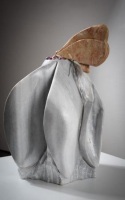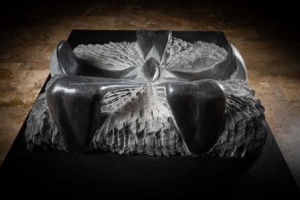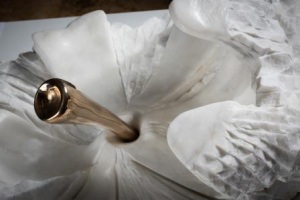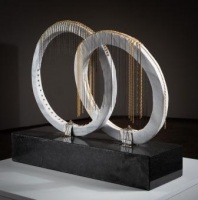Avi Sperber/Sculpting for Love
 The series of new art works by Avi Sperber on the topic of love, which are on display for the first time at the Jerusalem Theater, is dedicated to his late wife Leah, who passed away before her time. The sculptures display poetry that crosses boundaries, romantic talent and professional skill worthy of admiration, combining the massive power of stone with the dramatic and touching carving by an artist’s hand.
The series of new art works by Avi Sperber on the topic of love, which are on display for the first time at the Jerusalem Theater, is dedicated to his late wife Leah, who passed away before her time. The sculptures display poetry that crosses boundaries, romantic talent and professional skill worthy of admiration, combining the massive power of stone with the dramatic and touching carving by an artist’s hand.
According to Karl Jaspers, whom Sperber quotes in the essay he wrote for the opening of the exhibition, “Love cannot be grasped because it is an unfounded, assumed reality of the absolute consciousness.” This definition explains the artist’s decision to dedicate this artistic project to describing the day-to-day feelings that accompany his life and the experiences of memory in which he lives.
The result is a touching series of works that capture the viewers’ eye, inviting them to contemplate and even touch and feel the physical, but also the spiritual, power of the works. Each sculpture represents a feeling, a symbol and an idea that symbolizes a unit in the couple’s marriage, which lasted for fifty years. The allegorical sculptures, which represent a labor of love for the artist and dedication to his goal, are a kind of translation of the personal, intimate sights taken from the innermost parts of Avi Sperber’s spirit and brought out into the world.
 The legendary sculpture garden at the Israel Museum in Jerusalem, which contains the famous “Ahava” (Love) sculpture by Roberg Indiana and “Vertebrae” by Henry Moore. There is a certain symbolism in the new “addition” that Avi Sperber has brought to Jerusalem on the topics of love and vertebrae. A series of couples, worked in stone, embracing one another, powerful and massive circles of energy that commemorate an endless love: these are the sculptures entitled “The Romantic Utopia,” “Two Who Are One,” and “Constrained Connection.” The deep link and true and candid inner connection between the couple is symbolized by these sculptures, and illustrates them in the clearest possible way.
The legendary sculpture garden at the Israel Museum in Jerusalem, which contains the famous “Ahava” (Love) sculpture by Roberg Indiana and “Vertebrae” by Henry Moore. There is a certain symbolism in the new “addition” that Avi Sperber has brought to Jerusalem on the topics of love and vertebrae. A series of couples, worked in stone, embracing one another, powerful and massive circles of energy that commemorate an endless love: these are the sculptures entitled “The Romantic Utopia,” “Two Who Are One,” and “Constrained Connection.” The deep link and true and candid inner connection between the couple is symbolized by these sculptures, and illustrates them in the clearest possible way.
Other sculptures by Sperber bring us to the sensitive boundary of the language of the body and the personal, unmediated touch that he has given to each sculpture over the years. Avi Sperber’s work is typified by the connection between a precise choice in the kind of stone and the artificial materials that are connected to it, and the physical chiseling that he does by hand imbues them with strong energetic powers. He chooses well-known mythical symbols such as an eaten apple placed beside a shell, and creates images of organic plants, flowers, and petals that open to the world and presented, with their open hearts, to the world. In each of his sculptures, which link to the relationship between male and female, between himself and his masculinity and his wife and her feminity — in all of these, he uses sculptural motifs that are romantic, erotic, and poetic, and holds a silent dialogue with the flower works of Robert Mapplethorpe and Georgia O’Keeffe.

The endless love that is sculpted by Avi Sperber and that illustrates the memory that exists within him is given meaning in a work in the form of the number eight, which symbolizes perpetual motion. It calls to mind the braid of his wife Leah, and the etchings, in the form of human scratches that characterize the work, only intensify the sense of truth and yearning. The images of the narcissus, which is presented in “Narcissus,” such a feminine, vagina-like, and erotic work, and of a cracked human being, whose heart is cracked down the middle with light constantly shining through it, are the high point of the exhibition. These are joined by the impressive work entitled “You Took Me By Storm,” inspired by Alterman, which leaves the exhibition’s mark on the viewers.
Doron Polak, curator
What Is Love?
What is love? Many people have tried to find the answer to this question, but so far no definite answer has been found.
An article on Wikipedia defines love as a group of emotions and experiences connected with a feeling of strong affection and/or profound identification with some being.
We express love for human beings, animals, plants, ideas, objects. We classify love as romantic love, parental love, self-love, love of humanity, and love of God, among others.
In reality, it is difficult to define love because it is elusive and difficult to grasp. As the philosopher Karl Jaspers wrote: “Love cannot be grasped because it is an unfounded, assumed reality of the absolute consciousness”.
Despite the difficulty in defining love, the subject has piqued the curiosity of philosophers, scientists, psychologists, and sociologists throughout the generations, drawing them to investigate and attempt to find the secret of its essence. The result is countless theories, each of which may contain part of the truth, but it seems that no theory has been found that expresses the essence of love completely and precisely.
Plato, unable to understand the idea of man and woman and the attraction between them, called love “a madness of the gods.”
Scientists found various explanations for biological and chemical aspects of desire and the wish for connection, such as the variety and makeup of the materials that flow throughout our bodies, and mainly in our brains, and their relationship to genes as sources of the urge to procreate, which lies at the basis of love.
Researchers of evolution, such as the anthropologist Helen Fisher, claimed that it was evolution that pushed for a permanent connection between male and female, and that love developed as a tool for choosing a mate.
The behavioral researcher Irenaus Eibl-Eibesfeldt claimed, on the other hand, that the birth of love stemmed from the connection between mothers and children.
Helen Fisher attempted to enumerate the components of love: desire, attraction, communication. But is love the combination of these things? When we analyze them chemically, we come up with words such as pheromones, dopamine, androstenone testosterone, hormones, phenethylamine, which rend neutral the essence of love.
While there seems to be something to this analysis, it seems that chemistry does not provide a full explanation for love, since love is not desire, but rather something beyond it — a feeling. It is a feeling that appears when feelings create images.
In his book The Art of Loving, Erich Fromm wrote that the desire for unity between the sexes is the most powerful force that surges within human beings. It is the result of the recognition that Adam and Eve attained after eating the forbidden fruit: that they were separate, different sexes — which led to great desire and to unity in order to stave off the fear of separation. He wrote that the character of love of any kind was recognizable in that it included the fundamental principles of giving, caring, responsibility, giving respect, and awareness.
For Erich Fromm, love is, first of all, giving, not taking. Giving is the highest expression of ability and power. Giving is the power of which love is born.
Awareness, on the other hand, is the compelling urge to delve into the root of the secret of the awareness beloved, into the innermost nucleus that comprises the essence. Love is the active penetration of one soul into another, in which the desire for awareness reaches satisfaction through unity. awareness is the ability to recognize all the nuances, changes, behavior, and feelings of the partner, and thus to attain oneness ?
In the act of love, in the giving of the self in the penetration of the other, I discover myself, discover both of us, discover the human being. This act lies beyond the boundaries of thought or words; it is an immersion in the experience of oneness.
In his book Women of the Bible, Adin Steinsaltz writes that the sages of the Talmud had a slightly different outlook. Unlike the animals, which God created as male and female, Adam was created as a single entity whose body was simultaneously male and female. Eve was created from one of Adam’s ribs — in other words, from one side of a single body. Since the division of Adam’s body into male and female, both parts have sought to become one again. This is not attraction for the purpose of procreation, as in the animal world, but attraction for the purpose of becoming one.
According to the Zen tradition, giving and receiving in the act of love is the same thing. Each partner is inside the other, and the distinction between giving and receiving becomes meaningless.
Khalil Gibran compares this giving and receiving to a bee’s attraction to a flower that is, for the bee, a source of life, while for the flower, the bee is an emissary of love. For both, the mutual giving and receiving of pleasure are both a need and a means to elevate the spirit.
The French philosopher Paul-Michel Foucault attempted to investigate how society determines our images about sexuality and what we understand of it in terms of desire and eroticism. He wrote that we are what we believe we are, and what we believe we are depends to a large extent upon the society in which we live. In other words, according to Foucault, what exists is not love, but rather very different social perceptions of it.
In accordance with this, our images of love are not biochemical but social. Romantic love, currently the most prevalent image of love, is only one model of many.
Romantic love is the idea of bringing the transitory feeling of falling in love into a framework of love as permanence. This idea was revolutionary in that it placed desire over social position and maintained that everyone everywhere had a right to happiness and love.
It was only during the twentieth century that the idea of marriage based on love merged with the idea of the nuclear family. Thus in our time, love became obligatory for our self-actualization through the other.
According to Foucault, the expansion of the use of the Internet made it into a forum for love with unique characteristics. Ironically, the Internet, super-modern as it is, seems to be a preserver of romantic love.
However, in his book Love Online: Emotions on the Internet, Aaron Ben-Ze’ev writes that the Internet has changed the sphere of romantic love dramatically, and that this change will only grow more rapid in the future. The existence of romantic flexibility online stands out in the context of romantic exclusivity. It is difficult to remain completely apart from the enormous variety of available and enticing options. When it is possible to contact many online users, it will be more difficult to gain the emotional advantages of a stable romantic framework.
Through the Internet, does the future hold the possibility of the relationships of Sodom and Gomorrah, or those of animals? What will happen to love?
The sociologist Eva Illouz believes that romantic love is not a primary topic in contemporary culture, but rather a cultural industry, economically speaking, in which the economy has been replaced by culture, and culture by a world of transitory and temporary commodities. Instead of being a refuge from the consumer market, romantic love is usually a partner of capitalism. Love has merged with the mass market and culture has merged with the mass media.
Cars, which provide privacy, have replaced the parlor as a place for courting. The connection between romanticism and the car became particularly significant with the development of drive-in movies.
Cars, advertising, and the cinema developed and promoted the vision of love as utopia. In other words, this was a commercialization of love for the purpose of reaching an exciting and romantic marriage that lasted forever, on condition that the couple took part in the culture of leisure. The romantic ethic matched the capitalist belief that relationships were to be evaluated via the logic of profit and loss.
The power of the romantic utopia lies in its ability to confirm the values of capitalism while making them into symbols of simplicity and pure sentimentalism. In romantic utopia, the world of products and material luxury vanishes, replaced by a spiritual abundance that contains a sophisticated appeal to authenticity, freedom, and pure emotion. Consumerism relies upon the urge for excitement.
Knowledge of human beings parallels the knowledge of God. In mysticism that comes from monotheism, the attempt to know God through the mind is dispensed with, and replaced by the experience of oneness with God, in which knowing God is no longer necessary.
Yet what about God’s love for us? Some maintain, as the Catholics do, that such love is conditional upon specific actions and rules. If we serve God in a specific way, he will love us. This is patriarchal love. The Protestants state that God’s love cannot be bought. It is grace, matriarchal love, which resembles a mother’s unconditional love for her child. Since this is a protective, all-embracing love, it cannot be controlled or bought.
What about maternal love? The evolutionary psychologist Ada Lampert, in her book The Evolution of Love, states that maternal love is the first love that appeared on earth, and is also the first love that we experience in childhood. Parental love is the beginning of the evolution of love. According to her, warm blood begets warm emotion, and mothers hold their children close to their bodies because the basis of motherhood is physical proximity. They hold their children on the left side so that the children will hear their heartbeat. In Ethiopia, parental love is compared to the mother ostrich, who, when her chick tries to break the tough eggshell as it hatches, she helps it with her own beak.
The philosopher José Ortega y Gasset stated in his book On Love: Aspects of a Single Theme that falling in love is a mystical event that bends the inclination of the man toward the new sun. In love, the woman offers the man the rare, magical opportunity to relate to another entity, without any reason, as he states. The woman is the force that ignites love, and the approach of the woman to her preferences in choosing a mate, which has change over history, in itself changes history.
Ayala Malach Pines, in her book Falling in Love: Why We Choose the Lovers We Choose, quotes Alan Watts’s definition of falling in love: “a ‘divine madness’ that is akin to a mystical vision… a thing that strikes like lightning.”
Later in the book, she lists the variables that influence falling in love: similarity in attitudes; proximity in geography, character, and beauty; reciprocal affection; satisfying needs; physical and emotional arousal; social influences; specific cues in the beloved’s voice, eyes, posture, and way of moving; readiness for a romantic relationship; and mystery.
The process of falling in love, which combines these components, has two stages: falling in love and love. The Italian sociologist Francesco Alberoni wrote that while falling in love was like taking off in an airplane toward the clouds, love was like landing and standing securely on the ground.
Sigmund Freud asserted that falling in love was reuniting with the object of one’s first love — most likely one’s mother. We do not fall in love by accident, but rather out of careful consideration, even if we are not aware of it. Our romantic choice is influenced by our childhood experiences.
This may be where the sexuality researcher John Money’s “lovemap” comes in. Money asserts that long before we choose our partner, we have already developed an emotional map, a template of circles of the brain that dictate what arouses us sexually and what will motivate us to fall in love with one person rather than another.
According to Carl Gustav Jung, every soul has an animus (a masculine soul) and an anima (a female soul), and the combination of their components determines the needs of adaptation to a member of the opposite sex and enables romantic love and connection between the sexes.
Love is an emotion that never dies. It is made up of moments in one’s private world — a world that is created from the moment of falling in love, when another person becomes significant, or in moments of loneliness that accompany the loss of a loved one over time. During love, from falling in love to parting, there are many moments of strong emotional feeling, each of which is a moment of excitement. Love trickles, like the trickle of every moment in time. Each drop contains memories and feelings of the moment that passed so quickly. Sometimes, we yearn to return to an old memory, to the feeling of a moment that passed, to bring back that drop of time that trickled away, taking the feeling of that moment along with it.
Despite the enormous excitement of falling in love, about which countless essays have been written, the sociologist Eva Illouz asks, in her essay “On the Importance of Soul-searching in Love,” how it is that our culture is silent about the mysterious moment when love ends.
The end of love can take place as a process or as an event in which our perception of the other person is suddenly shaken. Ceasing to love means ceasing to believe in the person whom our beloved claimed to be.
What happens at the end of love may fit the definition of José Ortega y Gassett: that falling in love and mysticism are similar phenomena, and that the cessation of love evidently resembles them.
The anthropologist Helen Fisher wrote in her book Anatomy of Love: The Natural History of Mating, Marriage and Why We Stray that the eye — not the heart, the sexual organ, or the brain — is the first organ of love, since the glance is what usually arouses the human smile.
In seeking to fall in love, courting is first done with the eyes and facial movements, and then with positions of the body, sounds, and only then with touch.
Falling in love is a combination of strong emotions that rise and fall, full of hope and uncertainty focused upon another person, to the point of nullification of everything else around us.
In her analysis of human behavior, Helen Fisher explains love and mate selection by evolutionary developments and chemical processes in the brain. She defines love as devotion; the lovers are like heroin addicts, chemically dependent upon one another.
Jealousy is also the outcome of the components of love. Natural selection acts for the benefit of what we call jealousy, since possessive creatures have greater success in procreating.
The poet John Dryden wrote: “Jealousy is the jaundice of the soul.” William Shakespeare defined jealousy between spouses as “the green-eyed monster which doth mock the meat is feeds on.”
Jealousy, which borders at times upon hatred, is not the opposite of love. In his book What Is Love, the psychologist Yoram Yovell writes that fear of betrayal or abandonment can result in hatred, since hatred is a fiery and fierce way of relating in which the hated person has deep significance in the spirit of the hater, who ruminates upon him a great deal, often unwillingly as well. Love and hatred can dwell alongside one another or even alternate at rapid intervals.
Marcianne Blevis, in her book Jealousy: True Stories of Love’s Favorite Decoy, explains that jealousy cannot be controlled. It surfaces without warning, causing people to doubt their worth and their charm. Jealousy is linked to human beings’ need to control the spiritual landscape of their partner as if their own existence depended upon it. A jealous person becomes like one who has been hypnotized. He is trapped, with no ability to free himself.
The explanations and analysis of love and its components from various points of view have erased its essence, the feeling itself. On the other hand, countless attempts have been made throughout history to express the emotion, the feelings that accompany it, in books, legends, poems, and expressions that have taken root in various cultures.
The apple has been a symbol of love ever since Paris judged the contest between Hera, Athena, and Aphrodite, who offered him an apple. He chose Aphrodite, the goddess of love, who offered him the love of the most beautiful woman on earth.
Hayim Nahman Bialik used the apple as a symbol of love in his poem “For An Apple,” in which he writes: “Would you like to know how it was I fell in love? I fell in love because of an apple.”
Miriam Yalan-Shteklis wrote in a children’s poem about disappointed love: “I gave Nurit a flower, small and pretty and blue. I gave Nurit an apple; I gave her everything. Nurit ate the apple, threw the flower into the yard, and went off to play with another boy.”
The Song of Songs, a biblical love story, expresses the yearning for love of a young woman of Jerusalem, who says: “I am dark and beautiful, women of Jerusalem… tell me of my soul’s beloved.”
In Ethiopia, the capital city was named Addis Ababa, which means “new flower,” in honor of the love of King Menelik II for the eucalyptus tree.
“Two are better than one,” says Ecclesiastes of the hope for oneness. This idea is expressed in many songs, such as the song by Dudu Barak, “Two Are Better”: “If things are dark and I feel sad, if things are gray and I feel hurt, you are my hope. If things are bright and I feel wonderful, if my whole world has been revealed to me, you are my serenity. Two are better than one….”
Ehud Manor, in his song “Key Word,” describes love as follows: “You know that I am you too, it’s both of us too, it’s between you and me. Nothing else is important, and my heart was touched, and we were born again. Oh, how I sigh! Oh, what magic there is between us!”
Nathan Alterman, in his poem “Never-Ending Meeting,” expresses uncontrollable, unstoppable love as follows: “You have taken me by storm. I will sing to you forever. In vain shall a wall enclose you; in vain shall I place a double door! My desire is for you, and your garden is for me, and toward me my body, dizzy and helpless, reels.”
Haim Pashti, in his book White Love, writes in his poem “White”: “And we loved with a white love… and we knew the magic of discovery as the fans were folded, our words to one another’s hearts… and we became a single body, you and I, in white love.”
Legends, as well as poems, contain expressions of various and strange kinds of love. One example is the myth of the beautiful lad Narcissus, who, on seeing his face in the waters of a swamp, fell in love with his own reflection so deeply that he wanted to unite with it in the water, and drowned.
There is also the ancient Greek myth of Daedalus and his son Icarus, who attempted to escape captivity by making wings of feathers, held together with wax, to fly home over the sea. Daedalus warned Icarus not to fly too close to the sun, lest the wax on his wings melt and he fall into the sea. But Icarus, who had fallen in love with the sun and yearned for it, continued to fly toward it, sealing his fate. Alex Epstein expresses this in his micro-story “Icarus in Love”: “Rain was falling in torrents once again. He came home and took off his wings. She asked: ‘Weren’t you going to fly today?’ ‘Where can I fly to?’ he said, hugging her. The sun came out the next morning.”
In Rachel Gottesman’s book, On Passion, the author describes the story of the tragic love between Pyramus and Thisbe, who fell in love even though their families were enemies. Their means of communication was a crack in a wall, through which they whispered words of love to one another. But their decision to consummate their love led to their destruction. This myth, which inspired Shakespeare to write his play Romeo and Juliet, shows that the protagonist in the story is the crack in the wall. In a world that is closed off and regimented, cracks in the wall enable a new reality to exist. When a crisis strikes, the cracks that are created are an opening for its rectification. As Leonard Cohen wrote in his song “Anthem”: “Ring the bells that still can ring/Forget your perfect offering/There is a crack in everything/That’s how the light gets in.”
In conclusion, on a personal note: In early 2014, I was deciding what the topic of my next exhibition would be. In the midst of my reflections — about, among other things, life and the journey I took over the past fifty years together with my beloved wife Leah and our growing old together, the expression “endless love” came to me, which brought up ideas for creating sculptures on the topic of love.
In late 2014, my wife was suddenly diagnosed with a diabolical, malignant disease that ate away at her flesh and claimed her life within several months. Several days before she died, I lay beside her, holding her hand, to help her fall asleep. Even as her death approached, I felt a moment of excitement that I keep in my heart, a moment that I will never forget, a moment when I knew what love was.
Avi Sperber































